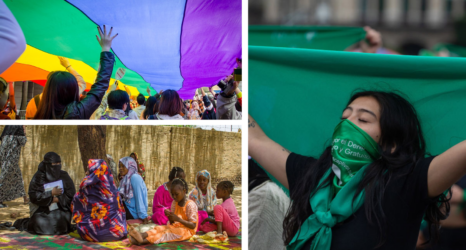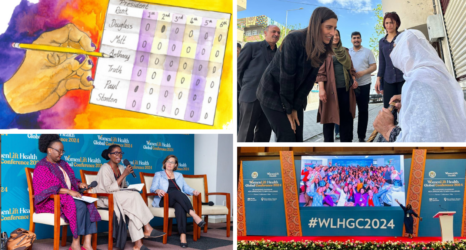As the Moroccan government increases repression of journalists, activists and artists, Moroccan photographer Fatima Zohra Serri makes women’s bodies and experiences visible—from menstruation to marriage to street harassment.

RABAT, Morocco — Before the coronavirus pandemic and ensuing stay-at-home orders began, Moroccan photographer Fatima Zohra Serri was already exploring what it means to make art in confined spaces, both cultural and physical.
“You can’t take pictures freely in my city, especially in the streets,” said Serri, 25, of her conservative home city, Nador, on Morocco’s northern coast.
So one of her latest posts on Instagram was shot inside, against a blank wall. A woman balances an inflatable globe on the bottom of her flexed foot. Her leg, criss-crossed by the threads of black fishnets, juts skyward, exposed. The dark folds of a burqa obscure her body, hair and face. But not her eyes. She fixes her gaze on the camera. We run this mother! reads the caption.
Navigating a society that often challenges women’s claim on public space, Serri has learned how to adapt—and thrive. As reported in Mille Magazine, she is one of 14 Moroccan photographers who recently formed the Noorseen Collective. The collective, they say, is an attempt to reclaim agency in representation and bind a budding community of creatives together through social media and, quite simply, a name.
For Serri, too, social media has been a space for critical creative thinking and a platform to broadcast her photographs. But her work is by no means limited to Instagram.
Since 2016, her work has been exhibited in Jerusalem, Marseille, Helsinki, Vienna, Marrakesh and, as of this year, in Rabat as part of the inaugural exhibition of the National Photography Museum.
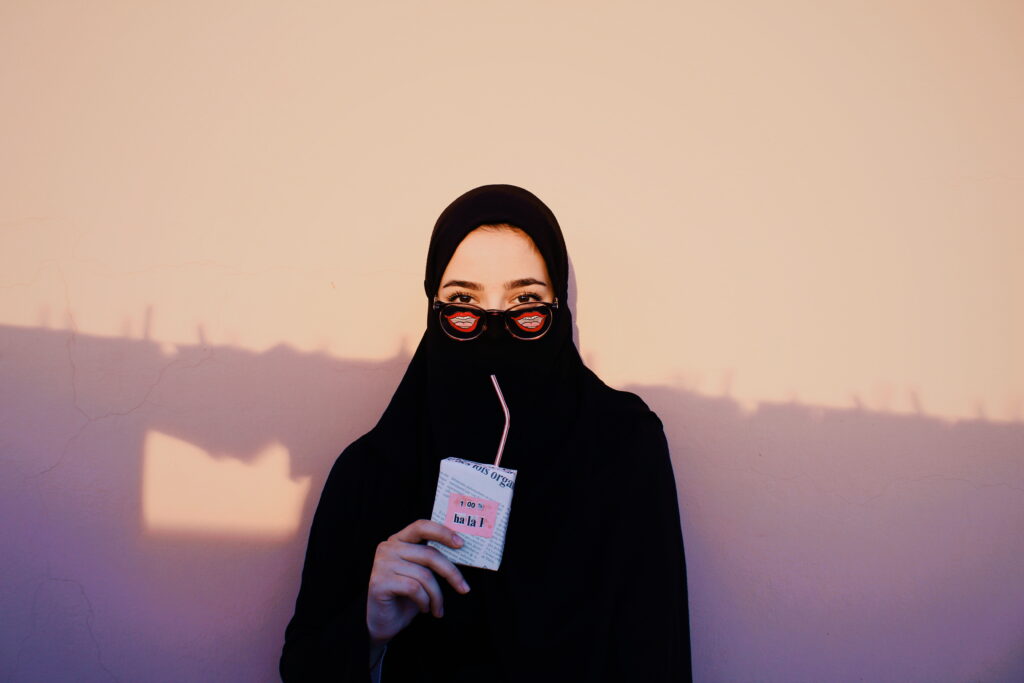
The exhibit, “Sourtna (Our Image): Moroccan Photographers of Today and Tomorrow,” was curated by prominent Moroccan photographer Yassine Alaoui Ismaili––alias Yoriyas––to showcase young artists who disrupt and transgress cultural taboos, like Mohamed Kilito does in his portrait of a lesbian couple, their love still a crime in Morocco.
Or Serri in her best known photograph: a blood-stained sanitary pad obscuring a girl’s eyes as her fingers gently interlace over her lips. The ruby, burgundy, brown designs on the carpet behind her start to look like entrails, discarded flowers, something rotting. She is almost laying within the stages of decomposition. Yet her lips and fingers remain clean. Within this contrast lies the sense of resistance. An elegant, unmistakable power.
Though Morocco is often lauded as the most progressive country for women’s rights in the Middle East and North Africa region, Moroccan women still face economic inequality, patriarchal laws and taboos about their bodies and sexuality.
“We are from a very conservative community, especially in my city, so this stuff is very sensitive,” Serri said over the phone, voice smooth and strong as river water, despite her confessed nervousness. “In Moroccan, it’s called hshuma,” meaning shameful.
Serri first turned to photography as an outlet for her depression after starting a full-time job as an accountant. Her quotidien was composed of sameness, solitude and a feeling of voicelessness—so for her, art proved cathartic. “I don’t know how to communicate properly—how to express my feelings, my thoughts,” said Serri, speaking English. “I try to talk through pictures.”
She started with street photography and self-portraits, using her smartphone. That was a few years ago. She has since bought a modest digital camera, a Canon she could afford. But Serri still has no formal training in photography and has chosen not to seek it out on the Internet. “I focus on the ideas more than the techniques or the camera,” she said.
An overheard offensive comment could be the spark that sets Serri’s creative energy ablaze. To tell her stories, the artist also draws on the experiences of her female friends, relatives and colleagues. She gleans.
“We are all feminists,” the artist added, a perspective shaped by these women and the work of the late feminist sociologist Fatema Mernissi. “If someone isn’t a feminist—if a woman isn’t a feminist—that’s the thing that is weird, not the feminist! All women must be feminists.”
The streets of Nador did not welcome her and her philosophy. So whenever possible, Serri would leave the city to work in nature. She would shoot in the ruderal periphery of her city, its margins, the grassy hills rising up around it. Or, come summer, in her grandmother’s village in the mountains outside of Fez, where Serri was born.
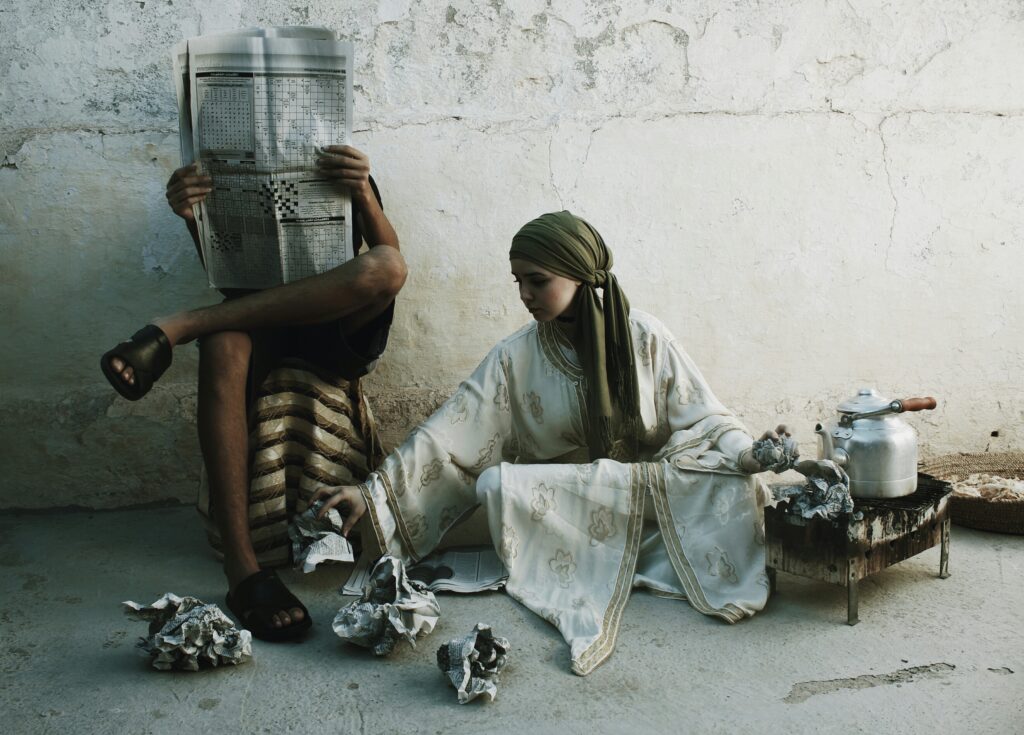
But with a strict lockdown in place in Morocco since late March, such mobility is just a warm memory. Luckily, Serri is accustomed to working inside, too. She often shoots at her home, seamlessly converting the mundane, the domestic into fertile soil for her subversive scenes.
To her, this confinement is both a creative challenge and a limitation. “I need more space. I need to go outside. I’m fed up with four walls,” Serri said.
In her photo shoots, the home is a backdrop; but in the “Sourtna” exhibit, it’s also a character in the show.
Once inside the museum, a dimly lit corridor opens to a wide chamber with an arched ceiling. Portraits of women encircle the room, which is styled to look like a living room with cushions and a traditional rug.
In the photographs, women bleed, clean, read, lounge, prepare for a boxing match. One watches a fire burn. Another one lights one. One woman sips from a cardboard juice box labeled 100% Halal through lips painted onto sunglasses, her own mouth concealed by her burqa. Another one stands on a roof next to an elegantly sketched vagina, breasts, a female nude.
Some photos are mounted directly to the walls; others in frames behind the glass doors of a china cabinet. They are like portraits of relatives whose names were lost but faces remembered. The unearthed jewels of a dispossessed queen.
In the back stands a print of a woman half-submerged in water, her legs and arms draped over the edge of a basin that glows the same cherry red as her lips. Like the globe-holder, she dons fishnet tights beneath her modest dress, a glass of milk in her hand.
The image is everywhere, within the museum and without and somewhere in the spaces in between. On tickets, brochures, an outdoor banner that undulates in the salt-soaked breeze.
As the Moroccan government has increased repression of journalists, activists and artists who challenge norms, Serri continues creating work that makes women’s bodies and experiences visible, from menstruation to marriage to street harassment.
In this state-funded museum, she subverts, challenges, even mocks cultural taboos—in part because she does not consider herself political. “Political? I don’t think so,” said Serri of her work. “It’s more about telling stories, experiences, expressing feelings.”
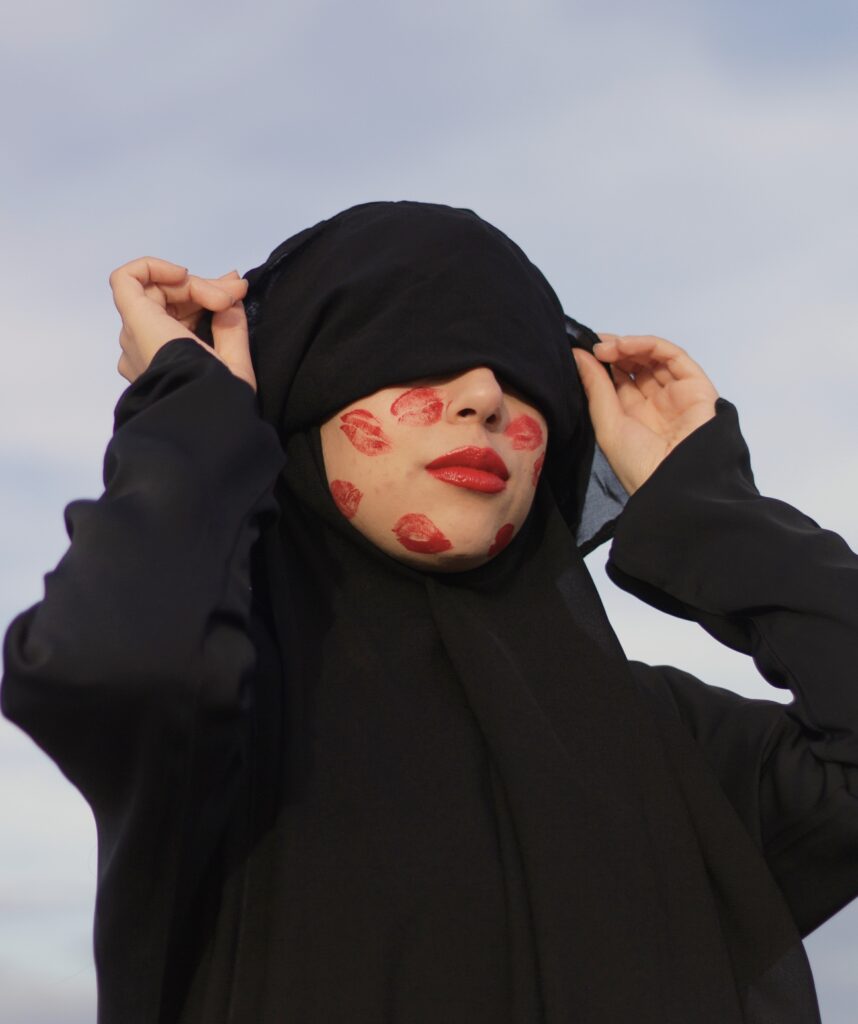
Still, Serri has struggled finding women to model for her. “It might cause them problems, with their families,” Serri said, “to be shown in pictures, in public.”
Serri, too, faced resistance from her family when she started sharing her work. “Firstly, they didn’t accept what I’m doing,” she said. “Girls here don’t do that. Especially the kind of art I’m doing.”
But since her success in exhibitions at home and abroad, her family’s opinions have evolved into support, she said; they even follow her on Instagram.
“There are a lot of people that don’t like my art, don’t like me, I don’t know why. But despite this, I feel free,” said Serri of her critics, who smatter her Instagram posts with their disparaging comments. They are like the grey seabirds, cawing and relieving themselves, dotting the seawall with white. Most judge her from a religious perspective. “I found something that represents me,” she said. “So why should I care about what people think?”
Only one set of critics—the women and girls disgusted by her photo of the sanitary pad—has cut to her heart and left it raw. Serri has watched them recoil in disgust, avert their eyes, shake their heads.
“How can you be ashamed of something that is natural, in your own body? How can you belittle yourself just because of it? I feel sorry for these girls, who see themselves like that, who reduce themselves to the word hshuma,” Serri said in a video filmed after the museum’s opening. In the clip, Serri walks the fort’s ramparts. Azure waves batter the wide beach behind her, dark save for a few clots of green algae.
“I must empower the women around me. I have to feel [for] them, to talk about them, to help them to fight for equality,” Serri said. Seeming to echo American bell hooks, she remarked that feminism “is about love.”
Serri updates her story on Instagram: her feet in mismatched socks/a cup of Moroccan mint tea/her cat. Friends with photo gear, singing a pop song/a black bra hanging from an open window/a snapshot of her shadow.
In response to the mandated lockdown, Morocco’s National Museum Foundation has set up virtual museum visits. You can visit the National Photography Museum here.
Up next:




